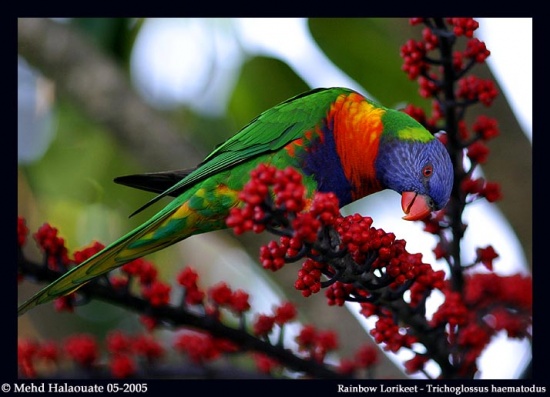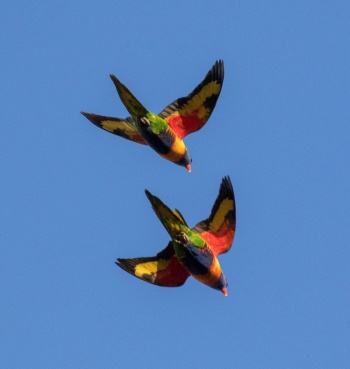(Flight picture. Basic tidy-up. References updated) |
Aloktewari (talk | contribs) (copyright symbol to image 1) |
||
| Line 1: | Line 1: | ||
| − | [[Image:Rainbow_Lorikeet.jpg|thumb|550px|right|Photo by {{user|mehdhalaouate|mehdhalaouate}}<br />Noosa Heads, [[Australia]], May 2005]] | + | [[Image:Rainbow_Lorikeet.jpg|thumb|550px|right|Photo © by {{user|mehdhalaouate|mehdhalaouate}}<br />Noosa Heads, [[Australia]], May 2005]] |
;[[:Category:Trichoglossus|Trichoglossus]] haematodus | ;[[:Category:Trichoglossus|Trichoglossus]] haematodus | ||
'''Includes: Biak Lorikeet; Coconut Lorikeet''' | '''Includes: Biak Lorikeet; Coconut Lorikeet''' | ||
Revision as of 16:44, 14 August 2019
- Trichoglossus haematodus
Includes: Biak Lorikeet; Coconut Lorikeet
Identification
The Rainbow Lorikeet is up to about 14 inches (35 cm) long. They weigh about 5 ounces (133 grams).
These parrots have brightly-colored red, green, blue, yellow, and orange feathers; the curved bill is red.
The males and females are hard to distinguish.
Distribution
Found from the Moluccas (Indonesia) to New Guinea and adjacent islands to eastern and south-eastern Australia.
Taxonomy
Several species have been split from these taxon recently: Red-collared Lorikeet, Leaf Lorikeet, Marigold Lorikeet and Sunset Lorikeet.
Gill and Donsker also split rosenbergii from Biak as Biak Lorikeet and the remaining subspecies into two species: Rainbow Lorikeet (Australia) and Coconut Lorikeet (Moluccas, New Guinea). However, other authorities have not yet adopted these splits.
Subspecies
About 11 subspecies are recognized[1]:
- T. h. rosenbergii: Biak Island (off northern New Guinea)
- T. h. intermedius: Northern New Guinea (Sepik River to Astrolabe Bay) and Manam Island
- T. h. haematodus: Southern Moluccas, western Papuan islands and western New Guinea
- T. h. nigrogularis: Eastern Kai Islands, Aru Islands and southern New Guinea
- T. h. brooki: Known from two cage birds from Trangan Island (Aru Islands)
- T. h. micropteryx: New Guinea east of Huon Peninsula; Kimuta and adjacent islands
- T. h. nesophilus: Admiralty Islands (Ninigo and Hermit groups)
- T. h. flavicans: New Hanover and Admiralty Islands
- T. h. massena: Bismarck Archipelago, Solomon Islands and Vanuatu
- T. h. deplanchii: New Caledonia and Loyalty Islands
- T. h.s moluccanus: Eastern and south-eastern Australia (Cape York to Eyre Peninsula, South Australia)
Habitat
The prefered habitat is coastal forests as well as urban gardens.
Behaviour
Noisy flocks of up to several hundred may congregate in flowering trees to feed and roost, at times in the company of Scaly-breasted Lorikeets.
Breeding
Breeding in the wild is from August to January. There are 2 to 3 white eggs in each clutch (a set of eggs laid in one nesting period). The eggs are laid in a tree cavity high above the ground. The female incubates the eggs for 25-26 days, and the male feeds her. Both parents will feed the chicks.
References
- Clements, J. F., T. S. Schulenberg, M. J. Iliff, D. Roberson, T. A. Fredericks, B. L. Sullivan, and C. L. Wood. 2017. The eBird/Clements checklist of birds of the world: v2017, with updates to August 2017. Downloaded from http://www.birds.cornell.edu/clementschecklist/download/
Recommended Citation
- BirdForum Opus contributors. (2024) Rainbow Lorikeet. In: BirdForum, the forum for wild birds and birding. Retrieved 17 June 2024 from https://www.birdforum.net/opus/Rainbow_Lorikeet
External Links





